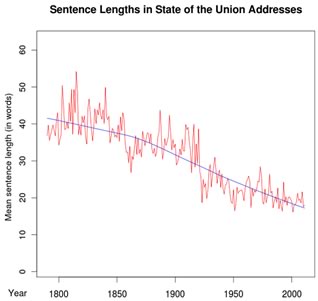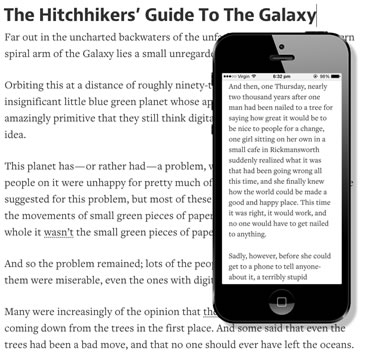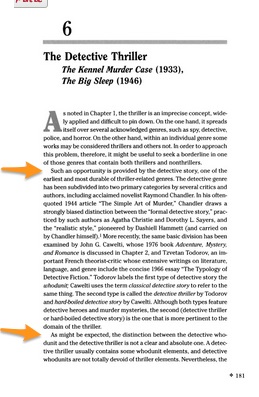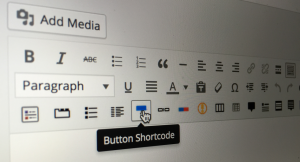
This is the original Magna Carta written in 1215. Parchment was very expensive in the 11th century, so thrifty scribes wrote in tiny, densely packed latin.
While it’s quite beautiful, the absence of paragraphs gives it a rather impenetrable look – even allowing for the latin. It’s hard for our modern eyes to traverse that sheer wall of text.
Why do we even need paragraphs?
Paragraphs serve three useful purposes in writing. Firstly they help the writer to order and organise their thoughts. Secondly, they give the reader ‘rest points’ as they work through the text.
And finally, paragraphs give us entry and exit points into documents – shortcuts for navigating around text. This is particularly useful on the web, where we know that readers browse, scan and snack on text much more than they do on printed texts.
What is the ideal paragraph length?

Predictably, there are lots of answers for this question, but the general consensus has been getting shorter for 200 years.
Mark Liberman from Language Log wrote a script that analyzed the structure of every US presidential ‘Inaugural Address’ and ‘State of the Union’ address since the late 1700’s. Of course, sentence length and paragraph length are different, but there’s certainly a relationship.
As Mark’s chart shows, average sentence length has gone from over 40 words per sentence, to less than 20 words in 2011. I don’t have a problem with this trend, but some do.
Whatever the driving forces, we’ve been continually selecting for shorter sentences and paragraphs for a long time.
Elsewhere Bob Brooke’s Writers’ Corner advises that you:
Try to limit your paragraph to five lines – not sentences. If it’s too long, break it down into a series of paragraphs on subtopics.Of course, on the web ‘five lines’ changes from device to device.
The Yahoo! Style Guide says:
Keep paragraphs short. Two to three sentences is often enough.
Which brings us to an interesting question
As FEDs/designers/UX people, we take responsibility for setting type sizing, line-heights, kerning, contrast, and all other typographic choices to create the best possible user experience.
1) Is it also our job to try to design the ideal paragraph lengths for our layouts? (I suspect most would say no).
2) The ‘ideal’ paragraph length surely must differ for different screen sizes? What is most comfortable to read on a Kindle or desktop surely isn’t the same as what works best on an iPhone.

Take this example of the same text on two devices:
On the phone above, a lot of the usefulness of paragraphs starts to disappear when you can only see one or at best two paragraphs at a time. We get a more ‘magna carta-esque’ wall of text.
So, what can we do?
In a perfect world it might makes sense to rewrite the content for different devices – ‘responsive content’. After all, we have different needs and expectations reading on a train than we do tucked up in bed, right?
Of course, the practicalities (and workload) of writing different content for each device/screen rules that out (for now at least).
But I’ve been thinking that there might be one layout trick that can help (a little) to fit more useful paragraphs onto mobile screens without needing to drastically shrink the text size.
On the web, paragraphs are almost always presented in the same way: They begin with non-indented text and end with a bottom padding equal to an empty line (like this very article).

But this is only one way of presenting paragraphs – albeit the most common method we see today. Until relatively recently most books looked like this:
There was no extra bottom padding on paragraphs – just a short indent on the first sentence of a few spaces. Almost all books and newspapers used this style of paragraph for most of two hundred years, until it began to fall steadily out fashion in the 1960s-70s.
Maybe there’s now good reason to re-introduce this old technique – JUST for our small screen layouts? Our wide screens won’t change, but media queries allow us to use those paragraph breaks more usefully on mobile view only.
This lets us maintain the familiar breathing space on larger screens but potentially provide more readability and a better UX on small screens. It won’t be dramatic, but it may be enough to put three paragraphs onscreen, rather than two.
This needs some proper UX testing, but I think it has merit.
What do you think?
Originally published in the SitePoint Design NewsletterFrequently Asked Questions (FAQs) about Paragraph Length
What is the ideal length of a paragraph in academic writing?
In academic writing, the length of a paragraph can vary based on the complexity of the topic and the depth of the discussion. However, a general rule of thumb is to keep it between 100 to 200 words. This length is enough to introduce an idea, provide some evidence, and draw a conclusion, without overwhelming the reader. Remember, the key is to maintain clarity and coherence in your writing.
How does paragraph length affect readability?
Paragraph length significantly impacts readability. Long, dense paragraphs can be intimidating and hard to digest, causing readers to lose interest. Shorter paragraphs, on the other hand, are easier to read and understand. They create white space on the page, which is visually appealing and gives readers a sense of progress as they move down the page.
Can a paragraph consist of just one sentence?
Yes, a paragraph can consist of just one sentence. This is often used for emphasis or to make a strong point. However, this should be used sparingly and not become a regular practice, as it can disrupt the flow of your writing and make it choppy.
How do I know when to start a new paragraph?
A new paragraph should be started when you are introducing a new idea or point. It can also be used to provide a contrasting viewpoint or to create a dramatic effect. If your paragraph is getting too long and complex, it might be a good idea to start a new one to maintain readability.
How does paragraph length vary in different types of writing?
Paragraph length can vary greatly depending on the type of writing. In academic writing, paragraphs are usually longer and more detailed. In journalism, paragraphs are often short and snappy. In fiction writing, paragraph length can vary widely to create different effects. It’s important to understand the conventions of your particular writing context.
How can I improve the structure of my paragraphs?
A well-structured paragraph should have a clear topic sentence, supporting sentences, and a concluding sentence. The topic sentence introduces the main idea, the supporting sentences provide evidence or explanation, and the concluding sentence summarizes the point or provides a transition to the next paragraph.
What is the role of transitions in paragraphing?
Transitions play a crucial role in maintaining the flow of your writing. They help to guide the reader through your ideas and arguments, making your writing more coherent and easy to follow. Transitions can be individual words, phrases, or even whole sentences.
How can I make my paragraphs more engaging?
To make your paragraphs more engaging, try to vary your sentence structure and length. Use active voice and vivid language. Include interesting facts or statistics. Make sure your writing is clear and concise, and always stay focused on your main point.
How does paragraph length affect SEO?
Paragraph length can affect SEO in a few ways. Search engines prefer content that is easy to read, and shorter paragraphs can improve readability. Also, having the right keywords in your paragraphs can help improve your search engine ranking.
What are some common mistakes to avoid in paragraphing?
Some common mistakes in paragraphing include making your paragraphs too long or too short, not having a clear main idea in each paragraph, not using transitions effectively, and not varying your sentence structure. Always remember to keep your reader in mind and aim for clarity and coherence in your writing.
 Alex Walker
Alex WalkerAlex has been doing cruel and unusual things to CSS since 2001. He is the lead front-end design and dev for SitePoint and one-time SitePoint's Design and UX editor with over 150+ newsletter written. Co-author of The Principles of Beautiful Web Design. Now Alex is involved in the planning, development, production, and marketing of a huge range of printed and online products and references. He has designed over 60+ of SitePoint's book covers.


